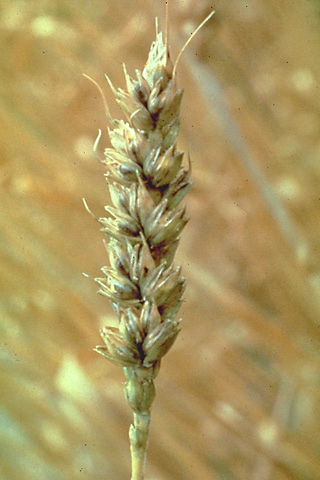General
Tilletia tritici and Tilletia laevis only differ in one gene and easily hybridize. There is debate whether they should indeed be considered separate species, since they cause the exact same symptoms.
Tilletia tritici and Tilletia laevis cause diseases such as common wheat bunt, stinking smut, karnal bunt of wheat.
Life cycle and appearance of Wheat bunt
Tilletia tritici and Tilletia laevis survive as teliospores in the soil or on seed. These teliospores germinate in response to moisture and form basidiospores, also called primary sporidium. Two mating types are distinguished. The filiform basidiospores fuse in the middle with a basidiospore of the other mating type so that H-shaped structures are formed. These can germinate directly or form secondary sporidia. These sporidia infect the wheat seedlings even before emergence and the fungi grow inside the plants to the growing tip. The fungi grow between the plant cells and eventually inside the kernels. When that happens, the fungal mycelium turns into teliospores and the whole kernel becomes a bunt ball full of teliospores. These balls break during harvest allowing the teliospores to fall to the ground. Additionaly, these teliospores contaminate healthy kernels, which in turn become a source of disease in the next season. Infection is strongly correlated to temperature and precipitation in the first 11 days after sowing, with maximum disease incidence at an average temperature of around 6 to 7 °C during that period. Soil moisture between field capacity and permanent wilting point is best for infection.
Damage symptoms
Plantsinfected by Tilletia tritici and Tilletia laevis are hard to distinguish from infected plants before head emergence, although affected plants may be slightly stunted. Infected (bunted) heads are slender and remain green longer than healthy heads. The glumes are opened either on some or on all spikelets, showing the bunt (smut spore) they contain, which is larger than a normal kernel. The bunt balls are grey-brown. They rupture at harvest and release black, powdery spores, that smell like fish, hence the common name stinking bunt.

Damage symptoms
How to prevent Wheat bunt
- Use resistant cultivars. However, the fungi may form new isolates that can break resistance
- Use clean, disinfected seed
- The use of soil fungicides can help reduce the soil-borne inoculum
- Sowing winter crops early in the fall when temperatures are still above 15°C at the critical first 11 days reduces the risk of infection by Triticum tritici and Triticum laevis. Since Triticum controversa mostly attacks the 2-3 leaf stage, this is less effective for this fungus
Prevent plant diseases by optimizing plant potential and crop resilience.